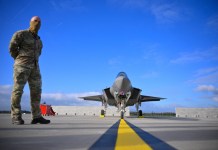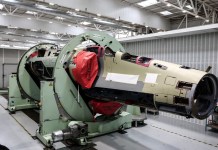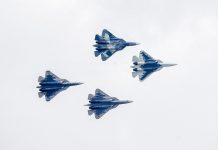Is the deployment of the US Missile Defence System in Japan worrying Russia? Moscow expects Tokyo to respond quickly on the deployment of US Missile Defence Systems in Japan. This was announced on Monday by Russian Foreign Minister Sergey Lavrov on the air of Komsomolskaya Pravda radio station.
“We expressed our concern to our Japanese colleagues at consultations and through the Foreign Ministry and the security councils. We expect a reaction from them, as this move has direct implications on us,” the minister stressed.
It became known earlier that the United States decided to put eight SM-3 Block 1B interceptors to Japan, as well as 13 new SM-3 Block 2A interceptors totalling $ 561 million. SM-3 Block 2A interceptor missiles, the development of which began in 2006, should replace the previous modifications.
They are supposed to be installed both on ships equipped with the Aegis multifunctional combat information and control system, and on the Aegis Ashore ground mobile missile defence systems. On October 26, the Missile Defense Agency and the US Navy announced successful testing of the SM-3 Block 2A in the Pacific Ocean.
In December last year, the Japanese Cabinet decided to deploy two Aegis Ashore complexes on Honshu Island in order to protect the country from the missile threat from North Korea. These systems are priced at $ 889 million each and should be installed by 2023.
US-Japan Defence Relations
Japan was among the first nations to participate in the U.S.-led Ballistic Missile Defense (BMD) project and decided to introduce its own BMD system in 2003. However, so far Japan’s BMD cannot function without U.S. technological capabilities, and most of Japan’s BMD developments are based on the presumption that the U.S. will remain a key partner.
Over the years, not only has BMD been an effective tool to stimulate the U.S. alliance and internal defensive capabilities, but also it has produced a platform resulting in a highly intricate integration of the two armies.
Japan can no longer say no to the United States — not just because of the broader alliance relationship but because of over-dependence on and integration with the U.S. military when it comes to defending Japan against ballistic missiles.
BMD has served Japan’s strategy very conveniently, enabling Japan to join the regional offence-defence arms race despite its pacifist constitution. The nature of BMD as a defensive system is a perfect fit for Japan’s strategy of “exclusively defence-oriented defence,” under which Japan has focused on defensive capabilities while relying on the U.S. nuclear umbrella. In a similar vein, BMD also strengthens the architecture of the U.S.-Japan security alliance – known as the “Sword and Shield System.” Along with Japan’s long-standing emphasis on the alliance as a crucial part of its security policy, BMD serves not only maintain the alliance but also strengthen it.
As the Diplomat writes, This is all the more crucial because, since the 1990s, Japanese policymakers have been concerned about potential “abandonment” by the United States after the end of the Cold War and the seeming decline in the U.S. geopolitical interests in the Asia-Pacific. As Daniel C. Sneider, an associate director of research for Stanford University’s Walter H. Shorenstein Asia-Pacific Research Center, told Asia Times, “the Japanese have this fear of abandonment. It’s deep-seated in Japanese strategic thinking.”
Given this fear, it’s interesting to note that BMD in Japan cannot function without U.S. military capabilities. The United States possesses Early Warning Satellites with the Space-Based Infrared System (SBRIS), operating in earth orbit, which cost more than $11 billion. The SBIRS allows the United States to constantly monitor the Asia-Pacific region, including North Korea, and detect any sign of potential launches. Japan does not yet possess such capabilities and hence receives information from the United States. Japan thus far has developed only ground-based radars, Aegis Destroyers’ radar, and Airborne Early Warning, which are helpful only in tracking missiles after a missile is launched. Thanks to the very short action time after a missile launch, a swift exchange of information to detect and track the missile is crucial, which necessitates both the use of U.S. satellites and enhanced interoperability to a substantial degree.
To ensure the effective functioning of BMD and serve the ever-growing necessity of maintaining the security alliance, Japan has made substantial efforts, leading to a seemingly excessive degree of military integration. First, with the revision of the U.S.-Japan Roadmap for Realignment Implementation in 2006, the limitation on the number of annual joint military training and exercises was eliminated, increasing the number of joint exercises. This goes in tandem with widening and deepening consultations and coordination. In terms of BMD, the strategy is now almost jointly planned, consulted, and implemented if necessary.
While the so-called two-plus-two meeting (where the defense and foreign affairs ministers from each country meet) has long a major platform for the alliance, now military official-level meeting occurs regularly. Within the framework of the Alliance Coordination Group (ACG), director general, director, and action officer-level meetings take place for military policy coordination. This possible after Japan established its own National Security Council with a similar structure to the U.S. NSC. The underlying legal framework to share classified information was strengthened through Japan’s Secrecy Law, substantially increasing the punishment for leaking classified information.
There are various consultation forums under the two-plus-two framework — such as the Security Subcommittee, Subcommittee for Defense Cooperation and Japan-U.S. Joint Committee — which are responsible for planning a strategy and its implementation with a particular focus on North Korea and BMD. Now the two militaries even have a physical platform to consult on a daily basis with the establishment of the Bilateral and Joint Operations Coordination Center at Yokota Air Base for the purpose of enhancing interoperability regarding air defense and BMD through sharing information between the headquarters of the Japan Self-Defense Forces (JSDF) and the U.S. forces.
There have been a variety of developments and frameworks to enhance interoperability specifically in terms of BMD. Most notably, Japan recently enacted legislation to allow the right of collective self-defense, which includes 10 provisions in the existing legal framework of the JSDF. The most significant part is arguably the addition of the JSDF’s mission to “take necessary measures to destroy ballistic missiles” headed for Japan’s allies as well as the protection of U.S. military equipment such as Navy vessels. These changes suggest Japan’s readiness to address a missile attack directed toward U.S. military bases in Guam and elsewhere. Furthermore, the decision to intercept missile is not unilaterally made by Japan, as the provision states “when the request is made by the armed forces of the United States.” This was also confirmed by former Japanese Defense Minister Itsunori Onodera.
It is no longer easy to tell the difference between the two militaries regarding BMD, apart from the flag. Japan even repairs and maintains the U.S. military equipment within Japan. At the same time, Japan and the United States jointly develop and use some of the core BMD equipment such as Standard Missile 3 Block IIA (SAM-IIA). Japan recently announced that Aegis destroyers will be equipped with the so-called Cooperative Engagement Capability by 2020, which makes it possible to share information simultaneously with the U.S. sensor and radar network. A Nikkei Asian report says that “CEC will be central to the plans for integrated air-and-missile defence capabilities that the Defense Ministry is drawing up.” This further blurs the distinction between Japan and the U.S. military regarding BMD.




